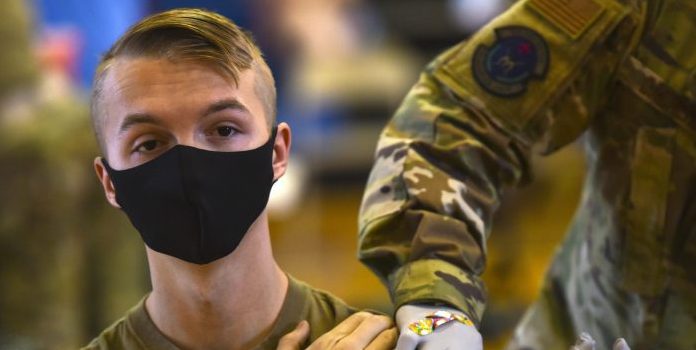(Headline USA) By the thousands, U.S. service members are refusing or putting off the COVID-19 vaccine as frustrated commanders scramble to downplay negative information they learn on the Internet and find the right pitch that will persuade troops to get the shot.
Some Army units are seeing as few as one-third agree to the vaccine. Military leaders searching for answers believe they have identified one potential convincer: an imminent deployment. Navy sailors on ships heading out to sea last week, for example, were choosing to take the shot at rates exceeding 80% to 90%.
Air Force Maj. Gen. Jeff Taliaferro, vice director of operations for the Joint Staff, told Congress on Wednesday that “very early data” suggests that just up to two-thirds of the service members offered the vaccine have accepted.
That’s higher than the rate for the general population, which a recent survey by the Kaiser Family Foundation put at roughly 50%. But the significant number of forces declining the vaccine is especially worrisome because troops often live, work and fight closely together in environments where social distancing and wearing masks, at times, are difficult.
The military’s resistance also comes as troops are deploying to administer shots at vaccination centers around the country and as leaders look to American forces to set an example for the nation.
“We’re still struggling with what is the messaging and how do we influence people to opt in for the vaccine,” said Brig. Gen. Edward Bailey, the surgeon for Army Forces Command.
He said that in some units just 30% have agreed to take the vaccine, while others are between 50% and 70%. Forces Command oversees major Army units, encompassing about 750,000 Army, Reserve and National Guard soldiers at 15 bases.
At Fort Bragg, North Carolina, where several thousand troops are preparing for future deployments, the vaccine acceptance rate is about 60%, Bailey said. That’s “not as high as we would hope for front-line personnel,” he said.
Bailey has heard all the excuses.
“I think the most amusing one I heard was, ‘The Army always tells me what to do, they gave me a choice, so I said no’,” he said.
Service leaders have vigorously campaigned for the vaccine. They have held town halls, written messages to the force, distributed scientific data, posted videos, and even put out photos of leaders getting vaccinated.
For weeks, the Pentagon insisted it did not know how many troops were declining the vaccine. On Wednesday they provided few details on their early data.
Officials from individual military services, however, said in interviews with The Associated Press that refusal rates vary widely, depending on a service member’s age, unit, location, deployment status and other intangibles.
The variations make it harder for leaders to identify which arguments for the vaccine are most persuasive. The Food and Drug Administration has allowed emergency use of the vaccine, so it’s voluntary. But Defense Department officials say they hope that soon may change.
“We cannot make it mandatory yet,” Vice Adm. Andrew Lewis, commander of the Navy’s 2nd Fleet, said last week. “I can tell you we’re probably going to make it mandatory as soon as we can, just like we do with the flu vaccine.”
At the Joint Readiness Training Center at Fort Polk, Brig. Gen. David Doyle, has a dual challenge. As base commander, he must persuade the nearly 7,500 soldiers on base to get the shot and he needs to ensure that the thousands of troops that cycle in and out for training exercises are safe.
Doyle said the acceptance rate on his base is between 30% and 40%, and that most often it’s the younger troops who decline.
“They tell me they don’t have high confidence in the vaccine because they believe it was done too quickly,” he said.
Doyle said it appears peers are often more influential than leaders in persuading troops — a sentiment echoed by Bailey, the Army Forces Command surgeon.
“We’re trying to figure out who the influencers are,” Bailey said. “Is it a squad leader or platoon sergeant in the Army? I think it probably is. Someone who is more of their age and interacts with them more on a regular basis versus the general officer who takes his picture and says, ‘I got the shot.’”
Adapted from reporting by Associated Press.

